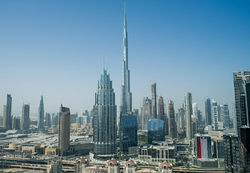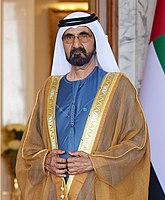Mina al-Majid
Mina al-Majid
| |
|---|---|
| Union Municipality of Mina al-Majid | |
 | |
| Nickname: "The Gateway" | |
| Country | Zorasan |
| Founded | 1349 |
| Founded by | Unknown |
| Government | |
| • Type | Union Municipality |
| • Body | Municipal Central Committee |
| • Governor | Hussein Al-Qasimi (NRF) |
| • City Administrator | Naim al-Riyadhi |
| • General-Secretary of the Union Municipal Assembly | Khalifah Hamadi |
| Area | |
| • Union Municipality and special economic zone | 1,320 km2 (510 sq mi) |
| Elevation | 11 m (36 ft) |
| Population (2022) | |
| • Urban | 3,222,793 |
| • Metro | 4,103,600 |
| Time zone | UTC+0:00 (Zorasan Standard Time (ZST)) |
| ISO 3166 code | ZO-MM |
| GRP (nominal) | €121 billion |
| GRP per capita | €29,590 |
| HDI (2020) | 0.809 |
Mina al-Majid, officially called the Union Municipality of Mina al-Majid (Rahelian: بلدية اتحاد ميناء الماجد; Ab-Baladiat al'Itihad Mina al'Majid; Pasdani: شهرری اتحاد ماجد; Šahrdâri-ye Ettehad-ye Majed) is the most economically and technically developed city in Zorasan, and its first specifically constructed Special Economic and Industrial Zone. Mina al-Majid is located on the northern shores of the Riyadha Peninsula, bound to the west, east and south by the Riyadhi Union Republic and the Gulf of Parishar to the north. With a population of 4.1 million, it is Zorasan's eighth most populous city.
Founded in the 14th century as a small fishing village under the name of Beit Massoud, it would remain an obscure coastal backwater until the mid-19th century, when its bay was chosen to serve as a coaling station and Entrepôt for Soravia and its trade interests in the wider Gorsanid Empire. It would steadily grow into a relatively prosperous mid-sized trading hub before coming under Etrurian jurisdiction in 1893. Under Etrurian rule, the city's importance would decline against that of Ghalliah to the south, which would become a major hub for Etrurian and Euclean traders. In 1946, the city well within the newly formed Emirate of Riyadha and in 1953, it became a major city within the Zubaydi Rahelian Federation. During the decade and early years of the 1960s, the city witnessed the development of its first petrochemical industries, establishing itself as the secondary export hub alongside Khadal in neigbouring Irvadistan. The city would be targeted during the First Rahelian War, with at least ten airstrikes on the city and its oil industry, the city during the war also served as the base for the Red Officers Movement, who would go on to overthrow the Zubaydi federal monarchy in 1968. Under the United Rahelian People's Republic, the city's fortune would decline as the socialist regime focused on expanding Khadal and Ghallilah, this would result in a steady decline in population. The city was captured with little resistance by Union of Zorasan forces in early 1978 during the Second Rahelian War, the Union's victory and subsequent unification of the United Rahelian People's Republic with the rest of Zorasan would lead to the city's transformation.
In 1988, the city alongside Bandar-e Sattari, Ashkezar, Khadal and Chaboksar were declared to become special economic zones as part of the New Generation Cities project. The NGC, launched in 1990 dramatically reformed the city's administrative and economic systems, now boasting markedly liberalised trade and investment laws, Mina al-Majid, alongside the other cities saw consistently high economic growth and were hubs for urban innovations and renewal. Aided by high energy prices, the Zorasani central government invested considerable funds into fostering Mina al-Majid into becoming a centre for finance, digital services and high-quality manufacturing. In thirty years, the city's economy and population boomed and has since emerged as a hub for technology, international trade, and finance, particularly insurance and Irfanic finance. Since the late 2000s, the Municipal Government has worked to establish the city as a centre for luxury, tourism and the creative services. It is the home to the Mina al-Majid Stock Exchange, one of the largest stock exchanges in the world by market capitalisation and the largest in Zorasan. In terms of GRP per capita, it is the wealthiest city in Zorasan and hosts the largest number of millionaires and billionaires in the country, overtaking Zahedan in 2011. Owing to the city's success, it also operates one of the strictest rules on internal migration in Zorasan and is regularly regarded as an elite city.
Etymology
According to Gorsanid records, Mina al-Majid was originally named Beit Massoud (بيت مسعود; lit. House of Massoud), the name would remain in use until 1798, when it was renamed to Beit al-Kanz (بيت الكنز; Lit. House of Treasure) by decree of the local Gorsanid governor, who wished to celebrate the town's success as a producer of pearls and bountiful catches of fish. Beit al-Kanz would remain the name under Soravian rule, but would change in 1893, when Etrurian colonial authorities renamed to Porta Nord (Northern Gate), in reference to its role as a entrepot and transit hub for goods entering and leaving Etrurian Rahelia. The name also links to the Etrurian twinning of the city with modern day Soltanabad, which they had renamed as Porta Centurione (Centurion Gate), this in turn related to its role as a defence along the Zorasani-Shangean border. Following the collapse of the Etrurian colonial empire in 1946 and the independence of the Emirate of Riyadha it was renamed to Mina al-Riyadha (مينا الرياضة, lit. Port Riyadha) in 1948. This name would again, remain in use until 1989, when in celebration of the city being earmarked for the New Generation Cities plan, it was renamed again by popular referendum vote to Mina al-Majid (مينا المجيد, lit. Noble Port).
History
Beit Massoud
Beit al-Kanz
Porta Nord
Mina al-Riyadha
Founding of modern Mina al-Majid
Development and boom
Present
Geography
Cityscape
Government
Relationship with Zorasani central government
Owing to the success of the New Generation Cities and Mina al-Majid in particular, the relationship between the Municipal government and federal government has often been tense and prone to bouts of tension. Of all the New Generation Cities, many inside and outside Zorasan classify Mina al-Majid as the most successful, though debate surrounds those most responsible, often divided between the central and municipal governments themselves. The success of Mina al-Majid has also led to numerous cases of its political leaders coming into fierce competition with other powerful figures with the Zorasani one-party state, where governors of Mina al-Majid become locked into power struggles with rivals upon the end of their two-terms, with natural expectation of elevation within national politics.
Other issues surrounding the relationship has been the requirement of Mina al-Majid to retain a more liberal socio-economic atmosphere compared to the rest of the country, for the sake of foreign direct investment and international trade needs. This situation remained low-key during the 1990-2005 period, known as the Saffron Era but became a consistently charged issue following The Turfan (2005-2008), when the Zorasani military and National Renovation Front right-wing factions conspired to restore and fortify ideologically hardline control over government. Under the Fifth (2005-2015) and Sixth (2015-2021) Leadership-Generations in particular, there were repeated clashes over Mina al-Majid's social policies and direction. This culminated in mid-2022 under the current Seventh Leadership-Generation, which orchestrated the removal of then Governor Faris al-Ababbar and City Administrator Abdullah Al Marri and secured the elevation of Al-Qasimi and Al-Riyadhi as their successors. This has served to ease tensions between Mina al-Majid and the Central Government since.




